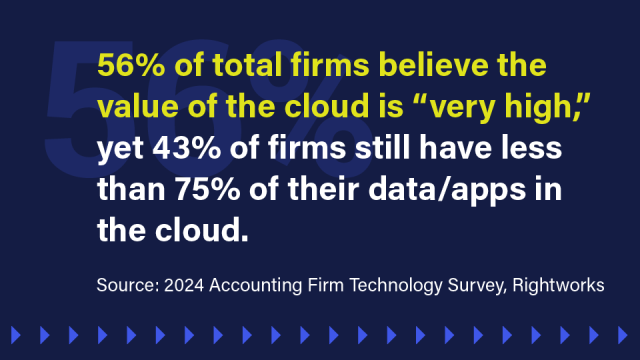This past fall, nearly 500 accounting, tax and bookkeeping firms participated in a groundbreaking technology survey. The 2024 Accounting Firm Technology Survey was designed to specifically identify the profitability of today’s accounting firms based on the maturity of their technology adoption.
The surprise finding? The more technologically advanced a firm, the higher the revenue—regardless of firm size. These technology-mature firms produced, on average, 39% more revenue per employee.
While conventional wisdom says larger firms generate more revenue due to the size of their clients and higher billing rates, this simply isn’t true. In fact, more than half of the firms in the top two technology tiers had 20 or fewer employees, pointing to “technology maturity” as a significant factor in firm revenue generation.
Technology maturity

To help survey respondents understand the level of their firm’s technology adoption, they were given a scale on which to rank their firm: The Modern Firm® Maturity Continuum. The five tiers are summarized below.
- Follower. Firms with a blend of manual and digital production processes with disconnected applications and inconsistent business processes.
- Initiator. Firms with mostly connected software solutions and standardized workflows in a secure cloud environment.
- Contender. Firms with well-defined and secure technology stacks in the cloud, standardized digital workflows and consistent end-to-end production processes.
- Collaborator. Firms with all the Contender capabilities but with “seamless” access to client accounting applications for improved collaboration.
- Leader. The most technologically mature firms, which took advantage of seamless access to client data, standardized workflows and a centralized data strategy leveraging technology and adoption of AI tools.
More IT maturity = more revenue
The survey found that Leader and Collaborator firms had 39% higher per-employee revenue than the bottom three tiers. When Contenders were added to Collaborators and Leaders, the average revenue per person was still 29% higher than that of the two least technologically advanced groups.
This validated the findings that the more technologically mature a firm was, the more revenue it produced. While a significant majority (75%) of the 493 firms that participated had 20 or fewer employees, they accounted for more than half the firms rated as a Leader or Collaborator, pointing to size not being a differentiator.
Technology drivers
The survey found that 88% of respondents recognize technology as a key driver of workplace efficiency and enhanced client service. Yet more than half of the firms fell into the Initiator or Follower tiers.
So, what’s the holdup?
Small to medium firms cited a lack of IT knowledge and the cost of new technology as barriers to adopting proven technologies. Larger firms highlighted resistance to change and implementation time as their top reasons for not adopting more technology.
The underlying theme of resistance is the perception that these technologies cost too much or don’t have an ROI. However, many industry analysts and the Leader and Collaborator firms that participated in this survey have debunked this.
Technology differentiators
When looking at what technologies made Leaders and Collaborators stand out, the overarching themes were clear: cloud, collaboration and adoption of emerging but proven technology. These themes should be the starting point for firms to explore to improve their practices.
No. 1: Cloud
Managing and securing an accounting firm’s IT infrastructure has never been more complex. And, to be honest, it surpasses the skills and resources of most firms that insist on managing IT themselves.
Doing the “bare minimum” year after year has put those firms further behind. It’s also limited their adoption of technologies—most of which have proven to be more effective—especially when managed by an enterprise-class cloud provider focusing on the accounting profession.
When firms consider the rising costs of IT expertise, today’s necessary security and the need for better firm/client collaboration, the benefits and ROI of moving to a cloud-based infrastructure become very clear.
No. 2: Collaboration
When asked about client collaboration, many owners envision clients dropping off documents and the team working internally to produce a tax return. This perception blinds many of them to the realization that everything can be done digitally today through integrated technology that is boundaryless in the cloud.
Despite collaboration being a critical component of firms, one-third of survey respondents felt that collaboration was the weakest part of their technology environment. Today’s cloud-based collaboration and workflow technologies allow firms to work more seamlessly and effectively internally with clients, including real-time access to the client’s accounting and information systems.
No. 3: Emerging accounting technologies
Many firm owners have a bad taste in their mouths. Why? Because of a long line of failed emerging accounting technologies that were oversold and underdelivered. This has put many of them into a wait-and-see mindset, freezing them from exploring new technologies.

AI, which consists of artificial and “augmented” intelligence, is different. The saying that “you won’t be replaced by AI but by someone using AI” has never been truer for accountants. Firms already use augmented intelligence tools such as application program interfaces (APIs), robotic process automation and machine learning.
CAAS practices connect and integrate data sources with accounting systems in the cloud, allowing for near real-time data insights and analysis. For generative AI, “colossal” mistakes made early on by ChatGPT users have stoked fear among accountants. But these fears can be easily overcome with basic education and by implementing proper guidelines.
Expect to see all the major accounting vendors (including Microsoft and Google) provide proven and “packaged” AI capabilities in their products, which will minimize the perceived risk of emerging technology adoption.
Technology adoption reaps revenue
Technology has undoubtedly had a significant impact on the accounting profession and how firms work. The results of this survey confirm that effective tech adoption boosts revenue, regardless of firm size. Understanding where your firm lies on The Modern Firm Maturity Continuum will help firms know what steps to take next to grow their practices.
See where your firm lies on The Modern Firm Maturity Continuum by watching our Accounting Technology Survey results webinar or by downloading the whitepaper today.



